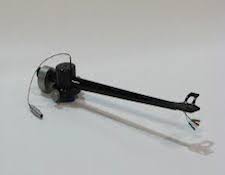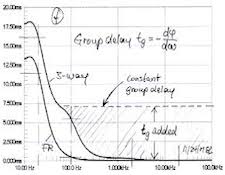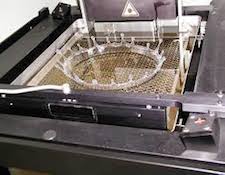It’s the time of year for saving money!
By now, most audiophiles have either read about, heard, seen and possibly even own the new VPI JMW-3D tonearm, which is the first of its kind in our industry. Rather than making a tonearm in the traditional method, that is machining and aluminum tubing processing, this tonearm is printed using a special process whose design premise is hardly new.
 3D printing, the type used for the JMW tonearm, is actually used by a wide variety of industries for a process called rapid prototyping. In fact, for very limited quantities, 3D Printing may also be used for production.
3D printing, the type used for the JMW tonearm, is actually used by a wide variety of industries for a process called rapid prototyping. In fact, for very limited quantities, 3D Printing may also be used for production.
In 1986, Charles W. Hull coined the phrase and patented a process known then as “Stereolithography” or “SLA.” Once the part design was loaded into the SLA machine, a beam of ultraviolet light was focused into a vat of liquid photopolymer. As the process went along, the part literally rose up, layer by layer. I used to do business with a large manufacturer of cash registers who used SLA to verify that their molded plastic parts could be assembled together as designed.
 Today, we have 3D engineering software like AutoCAD, Pro E and CATIA, all of which allow an engineer to not only design a part in a flat, one dimensional plane, but also as a 3D model that shows how the part will look once produced in real life. These software packages allow the engineer to actually assemble “part A” with “part B” on the computer. This ensures they actually fit together and the engineer can view the finished assembly in different planes and angles. This can save costly mistakes prior to production and before tooling and fixtures are built. I knew of an engineer years ago that lost his job because he designed two plastic parts to fit together and once the tooling was built, at a cost of about $150,000.00, it was discovered that one part was too large to be connected to the other. Correcting this mistake was obviously very expensive. Modern engineering software, as well as SLA then, and 3D Printing today, can easily eliminate those types of costly mistakes.
Today, we have 3D engineering software like AutoCAD, Pro E and CATIA, all of which allow an engineer to not only design a part in a flat, one dimensional plane, but also as a 3D model that shows how the part will look once produced in real life. These software packages allow the engineer to actually assemble “part A” with “part B” on the computer. This ensures they actually fit together and the engineer can view the finished assembly in different planes and angles. This can save costly mistakes prior to production and before tooling and fixtures are built. I knew of an engineer years ago that lost his job because he designed two plastic parts to fit together and once the tooling was built, at a cost of about $150,000.00, it was discovered that one part was too large to be connected to the other. Correcting this mistake was obviously very expensive. Modern engineering software, as well as SLA then, and 3D Printing today, can easily eliminate those types of costly mistakes.
I suspect the vast majority of audio companies use some form of engineering software and rapid prototyping. Most speaker companies, for example, not only design their speakers with 3D software, they use it to be sure all of the internal baffles and other structures fit together as designed. They then take that one step further and use flow analysis to address issues such as internal standing waves and how sound will actually be reproduced. Long before they ever reach the actual prototype stage, the manufacturer has a fairly good idea how their speaker will perform based only on computer modeling. After prototyping has been completed, production may begin.
 This whole process proves the design before building tooling, fixtures, buying raw materials and setting up an assembly process. However we may perceive them, audiophile companies are, at their core, manufacturers who employ the latest principals used in modern production.
This whole process proves the design before building tooling, fixtures, buying raw materials and setting up an assembly process. However we may perceive them, audiophile companies are, at their core, manufacturers who employ the latest principals used in modern production.
3d Printing is the today version of SLA. It was first known as “Fused Deposition Modeling,” and was commercialized by a company called Stratasys in the late 1980″s. In simple terms, an inkjet printer deposits a liquid binder on a special powder. Just as in SLA, the part rises out of the powder layer by layer. It is a particularly slow process and unlike SLA, the part can be used for fit, form and function. This is why the VPI JMW 3D tonearm can be made in this method and sold commercially. Were it made as an SLA type of part, only fit and form would apply. The one downside is that 3D printed parts are made rather slowly so if their use is to be as production ready components, the output will be lower than typical production volume and more expensive. Let’s face it, in modern manufacturing, slow means costly. In the case of the JMW-3D, there are sonic qualities that offer unique advantages over traditionally produced tonearms. And that is likely the reason the JMW-3D has been so highly praised and successful.
 So where do we go from here in regard to 3D printed parts? Well, it is important to understand that the parts will all be a plastic material. This process does not yet support the use of metal. And the use of plastics is not widespread in audiophile components. Not, I suspect, because of some perception of quality, but rather the initial costs associated with production molded plastics. Tooling for the injection molding process, for instance, can range from a few thousand dollars to hundreds of thousands. That cost is borne before one part is ever produced. High production volumes are required to offset the tooling costs. High volume, as we all know, is something generally not associated with high performance audio products.
So where do we go from here in regard to 3D printed parts? Well, it is important to understand that the parts will all be a plastic material. This process does not yet support the use of metal. And the use of plastics is not widespread in audiophile components. Not, I suspect, because of some perception of quality, but rather the initial costs associated with production molded plastics. Tooling for the injection molding process, for instance, can range from a few thousand dollars to hundreds of thousands. That cost is borne before one part is ever produced. High production volumes are required to offset the tooling costs. High volume, as we all know, is something generally not associated with high performance audio products.
3D Printed parts, on the other hand, may offer very unique production and sonic qualities. I suspect we will see more products made using this process. As the cost of the equipment comes down, and the process itself improves, the cost of sale should commensurately decrease. The acceptance from the audiophile community is the one unknown variable. If the JMW-3D is any sort of forecast, maybe we’ll see many more parts produced in this way. Because it is obvious 3D printing will continue to be employed in greater fashion now and in the years to come.





